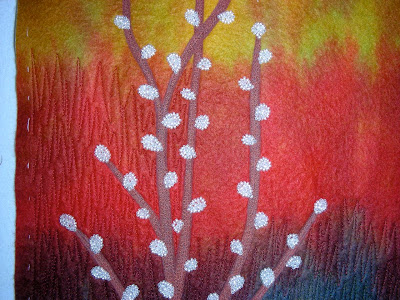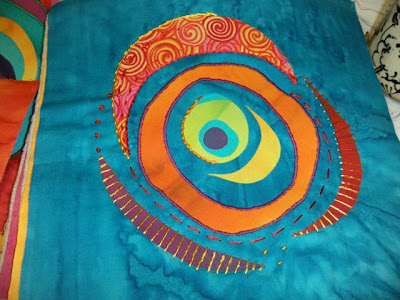Have you ever wondered what goes on behind the closed door during quilt show judging? I've had the pleasure of judging both large and small quilt shows all across the country. Though exact procedures may differ slightly from show to show, overall, much of the process is the same.
The Asheville Quilt Guild is preparing for their upcoming annual show and today was the first of two days for judging. Members are not permitted to judge the show, so because I don't hold any other position in the guild....which of course is run by volunteers, I offered to be a helper so I can give back a little bit to the guild. There are lots of tasks that need doing.
I thought I'd share a little bit about our day.

Each category is arranged on cloth covered tables.....with another cloth protecting them while they await their turn in the judging rotation. The
Asheville show is a large one.... over 200 quilts....
The judge or judges will judge all quilts in each category at one time. Volunteers 'fan' the quilts by folding each one back to give the judges a quick overview. Then the quilts are 'fanned' back to the original position. Next, each single quilt is held up for a closer view to observe impact, color, design etc. while another volunteer reads the description provided by the quiltmaker.
Next the judge/s examine the piece closer to access the construction. Scribes are standing by to record comments from the judge. Often the organizers have a specific form with breakdowns of areas they wish the the judge to respond to. That can mean a numeral rating or plus and minuses, or even such wording as 'satisfactory' or 'needs improvement.'
The most time consuming portion of this critique process is the comment section. We judges always like to provide both constructive and positive comments. For instance, the quilting stitches may be well executed, but the markings remain on the quilt (a big no, no.)

Whether working as a single judge or in a team, the next step is the decision to 'release' or 'hold' each piece. Holding means the quilt will be considered for an award. This is a way of narrowing down the group, often more quilts are 'held' then there are awards. After the entire category has been reviewed, the judges return to the hold table to make the final decisions.

Releasing means the quilt is no longer in contention for an award and is relocated to another table....after which it will ultimately be hung in the show with all the rest of the quilts.

Here, our two judges, Charlotte War Anderson (left) and Linda Fielder (right) examine a quilt as they confer with each other regarding the critiques they will be giving to the scribes.
Each quilt that is awarded a First Place ribbon is separated and will be reviewed again when all the quilts have been judged. It's from these quilts that the Best of Show quilt is chosen. All ribbon winners from whatever category that final quilt came from move up one position.....for instance, the second place winner now becomes a Blue Ribbon Winner.
Many shows have special awards as well. These generally recognize excellence in hand or machine workmanship, theme categories, judges choices. Most shows prefer that a quilt receive only one ribbon, rather than for instance, a First Place and Excellence in Color. This has the advantage of being able to recognize more quilts.
It's gratifying that so many quilters are willing to share their work for all of us to enjoy......I hope your fall will find you at a quilt show!
The
Asheville show will be held Sept. 30 - Oct. 2
nd. Click
here for more details.
 Our first stop was a fabric outlet just over the border in South Carolina. It's a large warehouse stuffed with bolts, rolls, flat folds, and huge boxes stuffed with smaller cuts of fabric. Think dumpster diving! Prices vary....and you won't find quilters cottons here. Rather, netting, dress woolens, sheers of all types, drapery fabrics are the norm.
Our first stop was a fabric outlet just over the border in South Carolina. It's a large warehouse stuffed with bolts, rolls, flat folds, and huge boxes stuffed with smaller cuts of fabric. Think dumpster diving! Prices vary....and you won't find quilters cottons here. Rather, netting, dress woolens, sheers of all types, drapery fabrics are the norm. Nancy is directing Val not to miss something. I swear Nancy could be a sales person at all the shops we visited....she knows their merchandise better then they do. You can see by this picture how cluttered and full the store is......making shopping feel like a treasure hunt.
Nancy is directing Val not to miss something. I swear Nancy could be a sales person at all the shops we visited....she knows their merchandise better then they do. You can see by this picture how cluttered and full the store is......making shopping feel like a treasure hunt. This huge box of zippers was at least 4' square and TALL. The zippers were $1.00 each......I brought some home and already have some ideas of how best to utilize them.
This huge box of zippers was at least 4' square and TALL. The zippers were $1.00 each......I brought some home and already have some ideas of how best to utilize them. The day continued with a visit to Hobby Lobby.....now you all may not think that's a big deal...but believe me....living here in the mountains we are Hobby Lobby and JoAnn Fabrics denied.
The day continued with a visit to Hobby Lobby.....now you all may not think that's a big deal...but believe me....living here in the mountains we are Hobby Lobby and JoAnn Fabrics denied.



















































